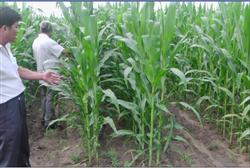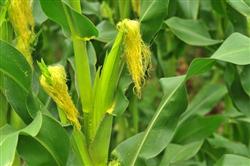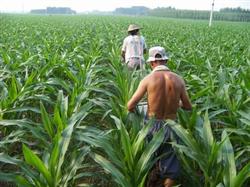Corn planting technology: how to manage summer corn in the middle and later stage?

How to manage summer corn in the middle and later stage? Please introduce some good management methods for summer corn in the middle and later stages of management: first, drought-resistant and waterlogging-resistant corn enters the vegetative growth and reproductive growth period after jointing, which is the key period of large panicles, and it is also the season of frequent occurrence of drought, waterlogging, wind, hail and other disastrous weather, so that drought can be watered and waterlogging can be drained in time. In July, we should pay close attention to watering with panicle fertilizer to relieve the drought as soon as possible and ensure the normal growth of corn. It is more important for corn to enter the later stage of watering, first, we should focus on watering the flowering water, because the male flowering is the critical period of maize water demand, and the lack of water will cause floret abortion and grain reduction. The second is to pour good grouting water, according to the rainfall, generally corn flowering to maturity should be irrigated with 2-3 water, in order to meet the water demand of corn flowering and grouting, at the same time, pay attention to flood control and waterlogging, and prepare for corn drainage in advance. Second, heavy application of ear fertilizer, supplementary application of grain fertilizer and good application of two fertilizers are the basis for achieving high yield and harvest of maize. It is generally mastered that the mu that has not applied seedling fertilizer is about 25 kg of urea, the grain stage is about 10 kg of urea, and the once application of seedling fertilizer is 20-30 kg of urea, so as to complete the task of topdressing and watering before heading. Third, in the middle and later stages of timely control of diseases and insect pests, corn borer, aphids, leaf spot and bacterial wilt were more harmful. In particular, corn borer occurs every year and must be controlled. In general, when the plant rate reaches 10%, 1% phoxim granules can be applied quantitatively to the heart and leaves of corn, about 1 gram per plant. Aphids can be sprayed with 1000 times of organophosphorus pesticides. The prevention of large and small spot disease and bacterial wilt is mainly to strengthen weeding in the field, drainage after waterlogging, dampness dispersing and cooling, so as to keep the field suitable for microclimate. Chemical control technology when 1-3% of the male ear in the field begins to be drawn out, 30 ml of Jianzhuangsu is mixed with 15-20 kg of water per mu, and the leaves are sprayed for chemical control. 6 hours after spraying, it is necessary to re-spray in case of rain, but the dosage should be halved. Fifth, timely harvest can ensure sufficient filling time for corn, which is an effective measure to increase grain weight, yield and income. The standard of corn maturity is the disappearance of milk line, and the general varieties can not reach the standard until about September 25, that is, 45-50 days after maturation. when the harvest time is delayed, the 1000-grain weight increases by 2-3 grams per day, and the grain yield increases by 5-6 kg / mu on average. Therefore, on the premise of not affecting the normal sowing of wheat in the next crop, the harvest time of corn should be postponed as far as possible. This technology does not increase any cost input, does not affect the sowing of wheat in the next crop, and has a significant effect on increasing production. Click to get more corn planting techniques click to get more food crop planting techniques
- Prev

Corn planting technology: what should be paid attention to in the middle and later period of summer corn?
What should be paid attention to in the middle and later period of summer corn? Please give the introduction of summer corn in the middle and later period to pay attention to the following points for reference: fertilization (1) ear fertilizer. Generally, nitrogen fertilizer is re-applied in the big trumpet mouth period, accounting for about 50% of the total topdressing amount, and standard nitrogen fertilizer is applied 30-40 kg per mu. (2) grain fertilizer. Generally account for 10% of the total amount of topdressing.
- Next

How to apply jointing fertilizer for summer corn?
How to apply jointing fertilizer for summer corn? When is the effect of applying jointing fertilizer good? Please give guidance on the jointing of summer corn after 18-21 days of emergence. As a sign of entering the jointing stage, from the external morphology, early-maturing varieties, such as Ludan 50, Yedan 20 and Denghai 9, spread 4 leaves and 10 leaves.
Related
- The first cup of black tea in spring, the flavor and history of tea gardens in Kenya, Africa
- The computer can not only choose potatoes, but also grow tea rice. AI will grow winter oolong tea champion.
- It is not only the inflated tea bitten by insects, but also engraved with the four seasons tea in Beipu.
- The Oriental Beauty Tea Festival in Zhuxian County takes the stage at the weekend to experience the plus-size feast of oil tea.
- & quot; Oriental Beauty Tea & Exploration of Emei in Hsinchu, the hometown of quot;
- The new variety of strawberry "Tainong 1" dessert is the first choice with mellow aroma. Crimson gorgeous
- History of Tea in Taiwan: from Wild Inner Mountain to Export Tea Garden
- Two types of Taiwan Oriental Beauty Black Tea won the British three-Star Award for Childhood Tea Xiang Zhang Jiaqi changed from pilot to champion tea maker.
- Banana species and varieties: the planting history of Taiwan Xianren banana and dwarf banana is long, is banana disease resistant?
- Coffee planting Technology: Qianjie Coffee from Seedling to harvesting

